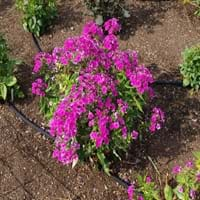Life Span
Perennial
Perennial
Origin
North America, Europe, Asia
Northeastern United States, Mid-Atlantic United States, Southeastern United States, North-Central United States, Central United States, South-Central United States, Canada
Types
Bigleaf hydrangea, Hortensia, Smooth hydrangea, Oakleaf hydrangea, Annabelle
Blue Ice, Eventide, Starfire
Habitat
Forest edges, Hillside, Woods
Dappled Shade, Shady Edge, Woodland Garden
USDA Hardiness Zone
Not Available
4-8
Sunset Zone
2a, 2b, 3a, 3b, 4, 5, 6, 7, 8, 9, 10, 11, 12, 13, 14, 15, 16, 17, 18, 19, 20, 21, 22, 23, 24
1a, 1b, 2a, 2b, 3a, 3b, 4, 5, 6, 7, 8, 9, 10, 11, 12, 13, 14, 18, 19, 20, 21
Habit
Upright/Erect
Upright/Erect
Minimum Height
Not Available
Minimum Width
Not Available
Flower Color
Blue, Dark Purple, Light Purple, Red, White
Purple, Magenta
Flower Color Modifier
Bicolor
Bicolor
Fruit Color
Not Available
Not Available
Leaf Color in Spring
Dark Green
Chartreuse, Gold
Leaf Color in Summer
Light Green
Chartreuse, Gold
Leaf Color in Fall
Dark Green, Gold
Chartreuse, Yellow green, Tan
Leaf Color in Winter
Gold, Tan
Not Available
Leaf Shape
Oblovate
Ovate
Plant Season
Spring, Summer, Fall, Winter
Summer, Fall
Sunlight
Partial Sun, Partial shade
Full Sun, Partial Sun
Type of Soil
Clay, Loam, Sand
Clay, Loam, Sand
The pH of Soil
Acidic, Neutral, Alkaline
Acidic, Neutral, Alkaline
Soil Drainage
Average
Well drained
Bloom Time
Early Summer, Summer, Late Summer
Summer, Late Summer, Early Fall, Fall
Tolerances
Wet Site, Salt, Soil Compaction
Not Available
Where to Plant?
Container, Ground
Ground
How to Plant?
Seedlings, Stem Planting
Seedlings
Plant Maintenance
Medium
Medium
Watering Requirements
Not Available
Average Water Needs, Doesn't tolerate standing water
In Summer
Average Water
Lots of watering
In Spring
Moderate
Moderate
In Winter
Average Water
Average Water
Soil pH
Not Available
Acidic, Neutral, Alkaline
Soil Type
Not Available
Clay, Loam, Sand
Soil Drainage Capacity
Not Available
Well drained
Sun Exposure
Not Available
Full Sun, Partial Sun
Pruning
Remove damaged leaves, Remove dead branches, Remove dead leaves
Remove damaged leaves, Remove dead branches, Remove dead leaves
Fertilizers
All-Purpose Liquid Fertilizer
General purpose slow-acting granular fertilizer
Pests and Diseases
Red blotch
Powdery mildew, Rust, Septoria leaf spot, Stem canker
Plant Tolerance
Wet Site, Salt, Soil Compaction
Drought
Flower Petal Number
Single
Single
Foliage Texture
Fine
Medium
Foliage Sheen
Not Available
Matte
Invasive
Not Available
No
Self-Sowing
Not Available
Yes
Attracts
Bees, Flies
Butterflies
Allergy
Chest tightness, Diarrhea, Dizziness, Nausea, Vomiting
Pollen
Aesthetic Uses
Not Available
Borders, Ground Cover
Beauty Benefits
Not Available
Not Available
Edible Uses
Not Available
No
Environmental Uses
Air purification
Air purification
Medicinal Uses
Fever, Kidney problems, Urinary tract problems
No Medicinal Use
Part of Plant Used
Flowers, Root
Not Available
Other Uses
Not Available
Used as Ornamental plant
Used As Indoor Plant
Not Available
No
Used As Outdoor Plant
Yes
Yes
Garden Design
Not Available
Cutflower, Feature Plant, Mixed Border, Wildflower
Botanical Name
DESCHAMPSIA cespitosa
PHLOX paniculata 'Goldmine'
Common Name
Tufted Hairgrass
Garden Phlox, Goldmine Phlox
In Hindi
Hydrangea
Goldmine Phlox
In German
Hortensie
Goldgrube Phlox
In French
Hortensia
Phlox Goldmine
In Spanish
Hortensia
Phlox Goldmine
In Greek
υδραγεία
Goldmine Phlox
In Portuguese
Hortênsia
Phlox Goldmine
In Polish
Hortensja
Goldmine Phlox
In Latin
Hibiscus
.org Phlox
Phylum
Not Available
Magnoliophyta
Class
Not Available
Magnoliopsida
Order
Not Available
Solanales
Family
Not Available
Polemoniaceae
Genus
Not Available
Phlox
Clade
Not Available
Angiosperms, Asterids, Eudicots
Tribe
Not Available
Phlocideae
Subfamily
Not Available
Polemonioideae
Number of Species
Not Available
Not Available
Season and Care of Tufted Hairgrass and Goldmine Phlox
Season and care of Tufted Hairgrass and Goldmine Phlox is important to know. While considering everything about Tufted Hairgrass and Goldmine Phlox Care, growing season is an essential factor. Tufted Hairgrass season is Spring, Summer, Fall and Winter and Goldmine Phlox season is Spring, Summer, Fall and Winter. The type of soil for Tufted Hairgrass is Clay, Loam, Sand and for Goldmine Phlox is Clay, Loam, Sand while the PH of soil for Tufted Hairgrass is Acidic, Neutral, Alkaline and for Goldmine Phlox is Acidic, Neutral, Alkaline.
Tufted Hairgrass and Goldmine Phlox Physical Information
Tufted Hairgrass and Goldmine Phlox physical information is very important for comparison. Tufted Hairgrass height is 120.00 cm and width 135.00 cm whereas Goldmine Phlox height is Not Available and width Not Available. The color specification of Tufted Hairgrass and Goldmine Phlox are as follows:
Tufted Hairgrass flower color: Blue, Dark Purple, Light Purple, Red and White
Tufted Hairgrass leaf color: Dark Green
Goldmine Phlox flower color: Purple and Magenta
- Goldmine Phlox leaf color: Chartreuse and Gold
Care of Tufted Hairgrass and Goldmine Phlox
Care of Tufted Hairgrass and Goldmine Phlox include pruning, fertilizers, watering etc. Tufted Hairgrass pruning is done Remove damaged leaves, Remove dead branches and Remove dead leaves and Goldmine Phlox pruning is done Remove damaged leaves, Remove dead branches and Remove dead leaves. In summer Tufted Hairgrass needs Average Water and in winter, it needs Average Water. Whereas, in summer Goldmine Phlox needs Lots of watering and in winter, it needs Average Water.




